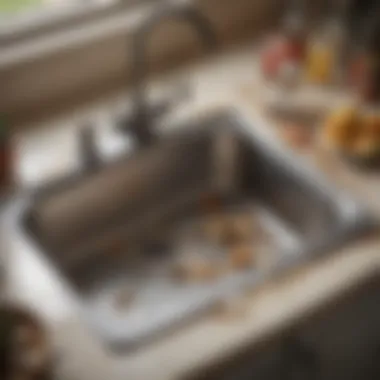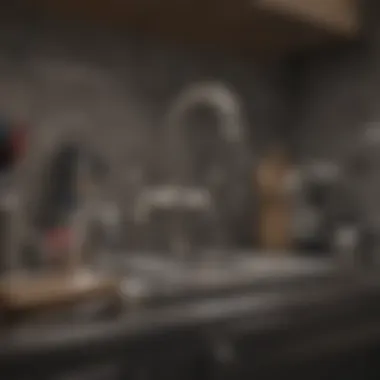Comprehensive Solutions for Sink Blockage


Intro
Sink blockages can present a frustrating dilemma for homeowners and renters alike. This article aims to shed light on the many causes of sink blockages and offer practical solutions to rectify these issues. It is crucial for homeowners to understand the underlying reasons for clogs, as well as the most effective remedies. The focus will be on actionable steps, ranging from simple do-it-yourself methods to more sophisticated interventions suitable for severe blockages.
The information provided will be beneficial not only to current homeowners but also to prospective homebuyers and real estate professionals. By being well-versed in sink maintenance strategies, one can enhance the longevity of plumbing systems and avoid costly repairs.
By delving into both the causes and the solutions to sink blockage, the subsequent sections will equip readers with essential knowledge about maintaining functioning sinks. You will find detailed explanations that highlight practical step-by-step fixes and preventive measures designed to keep sinks running smoothly.
Understanding Sink Blockages
In the realm of home maintenance, understanding sink blockages is essential for sustaining functionality in domestic plumbing. When sinks fail to drain properly, it signifies deeper issues at play. Awareness of common causes and solutions can save homeowners significant time and money. Furthermore, comprehension of the topic ensures readiness in addressing potential plumbing dilemmas.
What is a Sink Blockage?
A sink blockage occurs when the flow of water through the sink drain is hindered. This can lead to stagnant water, which poses a variety of inconveniences. Blockages can manifest in several ways and can arise from numerous causes, affecting both individual sinks and the broader plumbing system. Understanding the nature of sink blockages is vital for effective mitigation and prevention.
Common Types of Sink Blockages
Food Debris and Grease
Food debris and grease are frequent culprits behind sink blockages. When food particles wash down the drain, they can accumulate and form clogs. Grease, in particular, solidifies upon cooling, creating a hardened barrier that obstructs water flow. This type of blockage is notably prevalent in kitchen sinks where food preparation occurs. It is important to recognize the necessity of proper disposal methods to prevent such blockages from occurring.
Hair Accumulation
Hair accumulation is another significant factor contributing to sink blockages, especially in bathrooms. Hair strands can entwine with soap residue, leading to mats that block drains. This issue often surfaces gradually, as hair builds up over time. Regular cleaning and maintenance can mitigate this problem. However, homeowners must be vigilant about proper hair disposal to avoid excess build-up.
Foreign Objects
Foreign objects inadvertently finding their way into the sink can create considerable blockage challenges. Items such as toothbrushes, packaging materials, and even small toys can obstruct drainage. The nature of these obstructions can vary greatly, and they often require manual removal. Understanding the importance of supervising sink usage, especially in households with children, can help reduce the occurrence of this issue.
Pipe Corrosion
Pipe corrosion signifies a long-term problem that can lead to material degradation and subsequent blockages. Older plumbing systems, primarily those made from metal, are particularly susceptible to corrosion. This process can lead to rough pipe interiors that trap debris, exacerbating blockage issues. Awareness of the plumbing system's age and materials is crucial for proactive maintenance and preventing blockages related to corrosion.
Identifying Symptoms of Blockages
Slow Drainage
Slow drainage serves as an early warning indicator of potential blockages. Observing this symptom can help individuals identify problems before they escalate. Slow drainage typically indicates the beginning of a clog, allowing for proactive measures to be taken. Homeowners should consistently monitor drainage efficiency to recognize deviations from normal flows.
Gurgling Sounds
Gurgling sounds emanating from a sink often signal air trapped in the plumbing due to reduced water flow. This auditory symptom can be annoying and indicative of a blockage. It serves as a prompt for immediate investigation. Understanding the sound's implications can lead to timely action before more serious issues develop.
Bad Odors
Bad odors emanating from the sink can hint at organic matter decomposing within the pipes. These unpleasant smells can make a space uncomfortable and are often a precursor to clogs. Identifying bad odors as a sign of potential blockages encourages homeowners to take preventive actions and improve overall sanitation.
Water Backup
Water backup is perhaps the most dramatic symptom of a blockage. This condition manifests when water returns to the sink instead of draining properly. It is not only troubling but also poses health risks due to potential bacteria growth. Recognizing this symptom as an urgent issue can motivate prompt attention and remediation.
Causes of Sink Blockages
Understanding the various causes of sink blockages is crucial in identifying effective solutions and preventive measures. These causes often determine the severity of the blockage and influence the best strategies for resolution. By recognizing the different elements that contribute to a blockage, homeowners can take proactive steps to protect their plumbing systems and avoid costly repairs in the future. This section explores key factors that lead to sink blockages in residential settings, offering insights that can help maintain the integrity of plumbing infrastructure.


Everyday Contributing Factors
Many common habits and practices lead to sink blockages over time. These factors often seem innocuous, yet cumulatively they can create significant issues. Some notable contributors include:
- Food debris: Disposing of food scraps in the sink can lead to buildup, especially when combined with grease that solidifies and clogs pipes.
- Hair: In bathrooms, hair can easily accumulate in drains. When combined with soap scum, it forms dense clumps that further inhibit drainage.
- Soap residue: Like grease, soap can deposit in pipes, especially if it is not properly rinsed away. This residue attracts other particles, leading to more blockages.
These everyday habits illustrate how crucial it is to be mindful of what goes down the drain. By adopting better waste disposal practices, homeowners can minimize the residue that contributes to blockages.
Environmental Influences
The environment plays a significant role in the condition of plumbing systems. External factors, such as weather conditions and surrounding landscaping, can affect how well the drainage system functions. Some aspects to consider include:
- Flooding: Heavy rainfall can overwhelm drainage systems, causing backups and blockages. This can lead to serious plumbing issues and costly repairs.
- Tree roots: Roots from trees can infiltrate and invade sewer lines, leading to severe blockages. This issue often requires professional intervention to remove the roots and repair any damage.
Being aware of environmental influences can help homeowners take steps to protect their plumbing systems. This may involve regular inspections of drainage areas and implementing landscaping practices that prevent root encroachment.
Age of Plumbing Infrastructure
Finally, aging plumbing systems are a significant cause of sink blockages. The materials used in older systems often deteriorate, leading to increased susceptibility to blockages. Important considerations include:
- Corrosion: Older pipes, especially those made of metal, may corrode over time, leading to rough surfaces that trap debris and accelerate buildup.
- Outdated materials: Older plumbing systems may feature materials no longer considered adequate. For instance, polybutylene pipes have historically been prone to leaks and weaknesses.
Understanding the implications of aging infrastructure is essential for homeowners. Regular maintenance checks can identify potential issues before they escalate into significant blockages.
"Addressing the causes of sink blockages early can save homeowners significant repair costs and interruptions to their daily routines."
In summary, recognizing everyday contributing factors, environmental influences, and the implications of aging plumbing is paramount in maintaining functional waterways. Armed with this knowledge, homeowners can take proactive measures to safeguard their plumbing from common issues that lead to sink blockages.
Immediate Solutions for Blocked Sinks
Addressing sink blockages promptly is essential for maintaining the functionality of your home plumbing. Immediate solutions can prevent further damage and larger complications. When a sink is blocked, the inconvenience is noticeable. This section discusses effective methods to tackle the problem.
Using a Plunger
A plunger is oftentimes the first tool one can reach for when dealing with a blocked sink. The design of the plunger allows for the creation of suction, which can dislodge the materials causing the blockage. This method is beneficial because it is simple and does not require any special equipment. A cup-shaped plunger works best for sinks, as it has the proper shape to form a seal over the drain. When using a plunger, ensure to cover any overflow holes to maximize the suction effect.
Employing a Drain Snake
When a plunger fails, a drain snake may be your next step. A drain snake consists of a long, flexible metal coil that can reach deep into pipes. This tool removes stubborn blockages caused by hair, grease, or other debris. It is important that users exercise care while using the drain snake. Improper use may damage the pipes. Ensure the snake is inserted slowly and carefully to feel for the blockage.
Homemade Remedies
Homemade remedies can be a safe and effective way to unclog a sink without the harsh chemicals found in commercial products.
Baking Soda and Vinegar
Baking soda and vinegar create a chemical reaction that breaks down debris within pipes. This method is popular due to its eco-friendliness and effectiveness. The release of carbon dioxide from the reaction helps to agitate and break apart clogs.
One key characteristic of this remedy is its natural ingredients. This appeals to homeowners who prefer to avoid toxic cleaners. However, its effectiveness may be limited to lighter blockages, making it less reliable for severe clogs.
Salt and Boiling Water
Salt combined with boiling water provides another effective homemade remedy. Salt acts as an abrasive, while the high temperature of boiling water helps to dissolve grease and food particles. This method is beneficial for its simplicity and availability since most kitchens contain both ingredients.
However, the unique feature of this remedy is that it is most effective when used in a preventive manner. Regular maintenance with salt and boiling water can help minimize the risk of future blockages. Yet, caution is needed as boiling water can sometimes damage certain types of pipes, especially older ones.
Chemical Drain Cleaners


Chemical drain cleaners are widely available and can sometimes provide a quick solution to blockages. These products use strong chemicals to dissolve clogs. However, caution must be exercised.
Types of Chemical Cleaners
There are various types of chemical cleaners, including caustic and acidic options. Caustic cleaners use lye to generate heat and break down organic materials, while acidic cleaners often use sulfuric acid to dissolve clogs. Each has distinct mechanisms and should be chosen based on the nature of the blockage.
It’s a popular choice for handy homeowners, but it's critical to follow instructions carefully. Misuse can harm both pipes and users.
Safety Considerations
Safety is an important aspect of using chemical drain cleaners. Proper ventilation is necessary when applying these products, as fumes can be hazardous. Users should always wear gloves and eye protection. While these cleaners offer immediate relief, overuse can damage plumbing systems. Additionally, combining different types of cleaners can lead to dangerous chemical reactions. Always prioritize safety and consider alternatives whenever possible.
When to Seek Professional Help
Recognizing when to summon a professional plumbing service is crucial for effective sink maintenance. Not all sink blockages can be effectively resolved with DIY measures. Understanding the signs that indicate professional intervention is necessary helps prevent further damage. It also saves time and potentially costly repairs in the future. When left unaddressed, simple blockages can escalate into more significant issues, leading to extensive and expensive plumbing repairs.
Signs Indicating Need for Professionals
Several indicators suggest that a blockage needs a trained plumber’s expertise. Here are critical signs:
- Persistent Issues: If you repeatedly face clogs despite using home remedies, this suggests a more profound underlying problem.
- Severe Water Backups: When water backs up in multiple sinks or drains within your home, it points to a bigger systemic issue.
- Foul Odors: Unpleasant smells emanating from your sink may indicate decaying debris deeper within the plumbing, requiring specialized equipment for thorough cleaning.
- Or Unusual sounds: Strange gurgling noises during drainage could signal air trapped in the pipes or deeper blockages that need professional assessment.
- Visible Leakage: Any sign of leaks near the sink or plumbing fixtures suggests degradation or damage that requires immediate attention to avoid water damage.
"Ignoring signs of plumbing issues can lead to significant damage and increased repair costs."
Addressing these signs promptly could help mitigate severe issues before they escalate in complexity.
Choosing the Right Plumbing Service
Selecting a reputable plumbing service involves careful consideration. Not all plumbing companies offer the same level of expertise and reliability. To ensure you receive quality service, keep in mind several factors:
- Credentials: Confirm that the plumber is licensed and insured. This protects both parties and ensures you are dealing with trained professionals.
- Experience: Look for services with a history of dealing specifically with sink blockages. Experience related to your specific issue can often make a significant difference in the quality of the service.
- Reviews and Referrals: Seek feedback from past customers. Online platforms like reddit.com or local community reviews can provide insights into a company's reliability and service quality.
- Quotes and Transparency: Request quotes from multiple plumbing services. A transparent company will explain their process and charges clearly, helping you avoid unexpected costs.
- Emergency Services: Choose a service that offers emergency assistance. Issues with plumbing can arise at any time, and quick access to help can mitigate further damage.
By understanding when to seek professional help and how to choose the right service, homeowners can address plumbing emergencies efficiently, ensuring the longevity of their kitchen and bathroom systems.
Preventive Measures to Avoid Future Blockages
Preventive measures are essential in maintaining a functional sink and ensuring that blockages do not become a persistent problem. Addressing blockages proactively saves time, money, and frustration associated with plumbing issues. By implementing simple strategies, households can reduce the occurrence of clogs and enhance the overall efficiency of their plumbing systems.
Regular Maintenance Practices
Regular maintenance is crucial in preventing sink blockages. It involves checking and cleaning sink drains routinely, which can help identify potential issues before they develop into bigger problems. Here are some practices to consider:
- Monthly Inspections: Check for any signs of slow drainage or debris accumulation in the sink.
- Cleaning Drains: Use a mixture of baking soda and vinegar monthly to keep drains clear.
- Professional Inspections: Getting a professional plumber to inspect plumbing systems annually can prevent major issues that lead to blockages.
Regularly maintaining sink drainage not merely keeps things flowing smoothly but also adds to the lifespan of plumbing fixtures and systems.
Proper Waste Disposal Techniques
Understanding the importance of waste disposal can greatly reduce the risks of blockage. Improper disposal of certain materials often leads to clogs. Consider these points for proper waste disposal:
- Limit Disposal of Food Waste: Avoid putting excessive food scraps down the sink. Even with garbage disposals, certain items like bones and fibrous vegetables can cause issues.
- Avoid Grease: Never pour cooking oil or grease down the drain; instead, collect it in a container for proper disposal.
- Educate Household Members: Make sure everyone knows what can and cannot go down the sink.
Implementing proper waste disposal techniques not only protects the plumbing but also aids in maintaining a cleaner environment.
Installing Drain Screens


Drain screens act as physical barriers preventing debris from entering the plumbing system. These inexpensive tools are effective in minimizing clogs. Here are some key points about drain screens:
- Types of Screens: Various styles of drain screens exist. Choosing one that fits snugly in the sink opening is important.
- Regular Cleaning: Screens should be cleaned regularly to ensure they function effectively.
- Accessibility: Ensure that the drain screen is easy to remove and clean, enhancing its usability.
Installing drain screens is a simple yet very effective method to safeguard against sink blockages. They serve as a first line of defense, stopping unwanted items from causing clogs.
By embracing preventive measures, individuals can significantly mitigate the risk of sink blockages and maintain an efficient plumbing system.
Sustainable Practices for Sink Care
Sustainable practices for sink care are increasingly vital in today’s world where environmental consciousness is on the rise. As homeowners become more aware of the ecological impact of their choices, adopting these practices can minimize damage to plumbing systems and promote greater longevity. Readers will find this section salient, as it brings to focus essential steps for maintaining sink functionality while caring for the environment. These practices not only help in effectively mitigating blockages but also align plumbing maintenance with ecological mindfulness.
Eco-Friendly Cleaning Alternatives
Routine cleaning of sinks is necessary for their upkeep, but standard cleaning agents often contain harsh chemicals. Many of these products can corrode pipes and contribute to environmental degradation. Eco-friendly alternatives offer a sustainable solution. Common options include using baking soda, vinegar, or citric acid.
- Baking Soda and Vinegar: Combining these two household staples creates a reaction that can dissolve grime and buildup. Pour a half cup of baking soda down the drain followed by a half cup of vinegar. Wait for about 30 minutes, then flush with hot water.
- Castile Soap: Made from natural plant oils, this soap is gentle yet effective in cleaning tough grease.
- Essential Oils: Oils such as tea tree or peppermint not only provide a pleasant scent but also possess antibacterial properties.
- Lemon Juice: The acidity in lemon juice can break down bacteria and organic matter in sinks.
By choosing such alternatives, you preserve the integrity of your plumbing while contributing to a cleaner environment.
Water Conservation Techniques
Another crucial aspect of sustainable sink care is water conservation. It is essential for reducing utility bills and protecting this vital resource. Implementing simple strategies can make a significant difference.
- Install Aerators: These are low-cost devices that can be attached to faucets to reduce water flow without sacrificing pressure.
- Fix Leaks Promptly: A small leak can waste a considerable amount of water over time. Regular checks will help identify and remedy leaks quickly.
- Limit Running Water: Be mindful of the water you use while washing dishes or brushing teeth. Turning off the faucet when not in use can save gallons of water daily.
- Use a Bucket: While washing the sink or dishes, using a bucket to catch runoff can be a practical way to conserve water.
Adopting these water conservation techniques in sink care promotes a more sustainable household, leading to significant benefits for both the environment and homeowners.
The Impact of Sink Design on Blockages
The design of a sink plays a crucial role in its functionality and susceptibility to blockages. A well-thought-out design can minimize the risks associated with clogs, making maintenance easier and enhancing the longevity of plumbing systems. Understanding the impact of sink design provides valuable insights for homeowners, real estate enthusiasts, and interior design aficionados who prioritize both aesthetics and practicality in their spaces.
Porous Materials vs. Smooth Surfaces
When considering sink materials, the choice between porous and smooth surfaces influences blockage potential significantly. Porous materials, such as certain types of natural stone, can retain particles and residues more easily. This leads to nearly immediate accumulation of food debris and grease, which is a common cause of clogs. On the other hand, smooth surfaces like stainless steel or fiberglass allow for easier cleaning, making them less prone to trapping debris. Maintaining a smooth finish minimizes the chances of particles adhering, thus reducing blockage incidence.
It is also important to note that maintenance routines can depend on the chosen material. For porous sinks, regular sealing and thorough cleaning are necessary to prevent debris build-up. In contrast, smooth surfaces often require less frequent attention but should still have a cleaning schedule to maintain their effectiveness and aesthetic appeal.
Importance of Drainage Slope
The drainage slope of a sink is another critical element that affects how water flows through the plumbing system. An insufficient slope can cause water to pool, leading to stagnant water and increased likelihood of blockages. Ideally, drains should be angled downward to facilitate the movement of water and waste.
"Correct drainage slope is essential for efficient waste removal and can prevent many common plumbing issues."
If a sink has a poor drainage slope, it may require adjustments or professional installation to correct this issue. Homeowners should be aware of how the slope impacts their specific plumbing to ensure long-term functionality. Regular checks and maintenance of the drainage system can help identify slope issues before they turn into significant problems.
Overall, the design elements of sinks—ranging from materials to drainage slope—are vital considerations that can influence blockage occurrences and plumbing health. Understanding these factors allows homeowners and design enthusiasts to make informed choices that not only enhance the beauty of their spaces but also ensure efficiency and functionality.
Closure: Insights into Sink Maintenance
Sink maintenance is crucial for ensuring the proper functioning of a household's plumbing system. This article has highlighted critical elements related to sink blockages, such as causes, practical solutions, and preventative measures. Understanding the intricacies of sink maintenance equips homeowners with the knowledge necessary to address issues proactively, ultimately saving both time and expenses.
Given the various factors contributing to blockages, such as food debris, hair accumulation, and even pipe corrosion, it is vital to adopt a holistic approach to maintenance. Regular upkeep minimizes the chance of severe plumbing issues, allowing for better flow and efficiency in daily activities. Furthermore, being aware of how sink design impacts drainage can inform homeowners' choices during renovations or new constructions.
Summary of Key Points
- Understanding Blockages: Identifying the different types of blockages helps in choosing appropriate remedies.
- Quick Solutions: Immediate solutions like plungers and drain snakes can often resolve problems without professional help.
- Professional Intervention: Knowing when to call a plumber is essential for avoiding unnecessary damage.
- Preventive Measures: Regular maintenance practices, such as cleaning and proper waste disposal, reduce the likelihood of future problems.
- Sustainable Practices: Eco-friendly options not only protect the environment but also contribute to sink longevity.
Final Thoughts on Home Care
Home maintenance is an ongoing commitment that pays off in the long run. By fostering an informed approach to sink care—recognizing signs of potential blockages, implementing effective cleaning techniques, and maintaining a sustainable plumbing system—a homeowner can ensure a stress-free experience. Whether it is through DIY methods or professional assistance, effective maintenance ultimately leads to smooth and efficient sinks in any home.
The wisdom gained from understanding sink blockages serves not only to address current issues but also to lay the groundwork for a more robust plumbing infrastructure in the future. Embracing these insights transforms the perception of household maintenance from a mere task into an integral part of home ownership.















